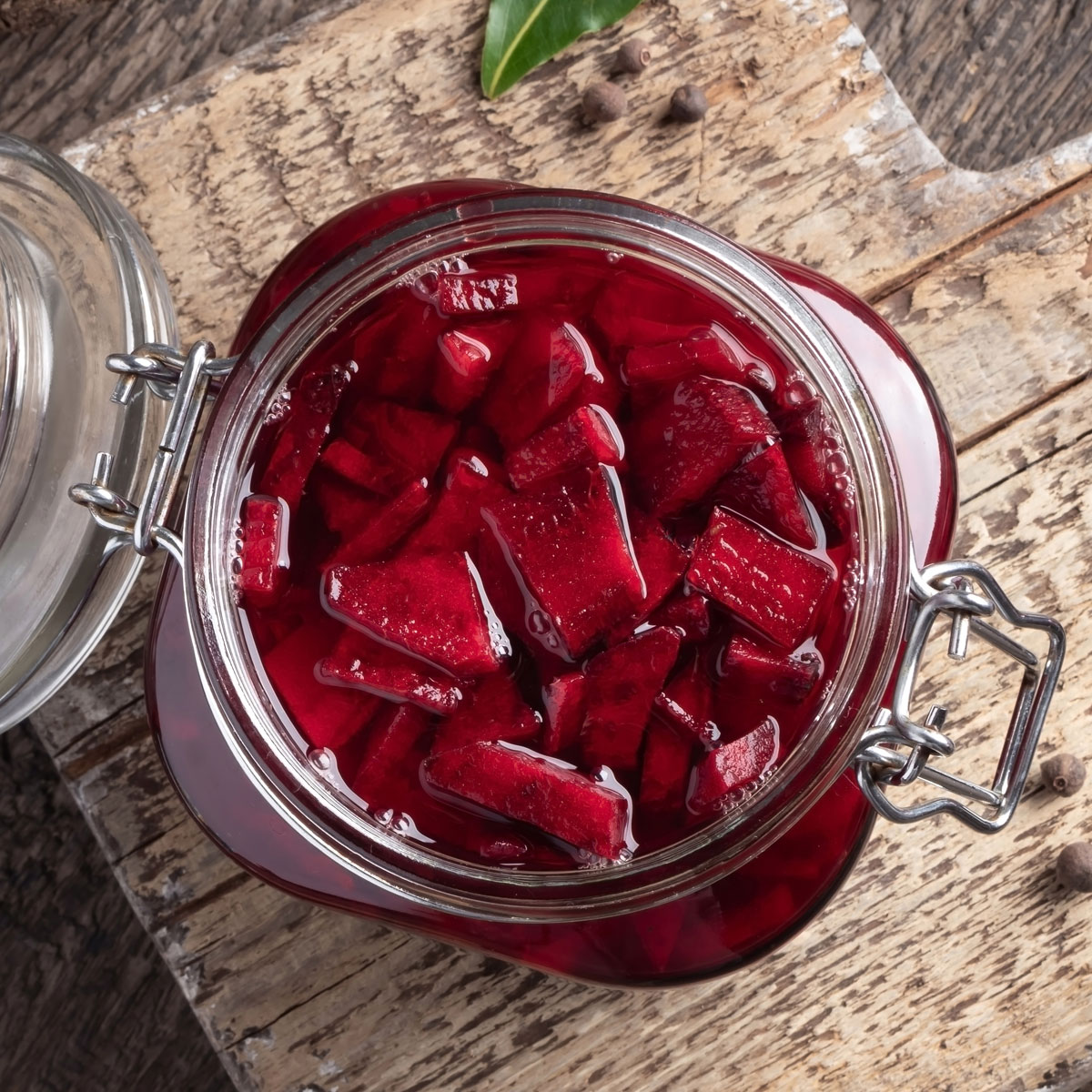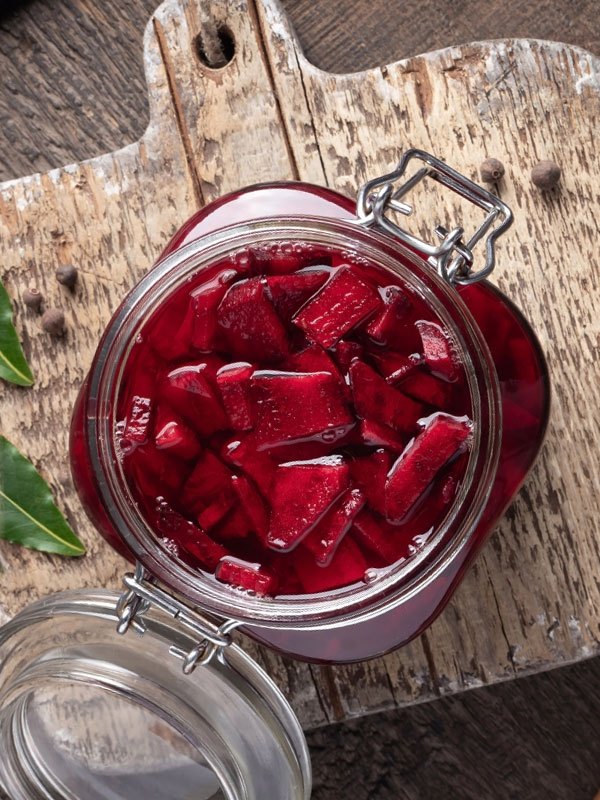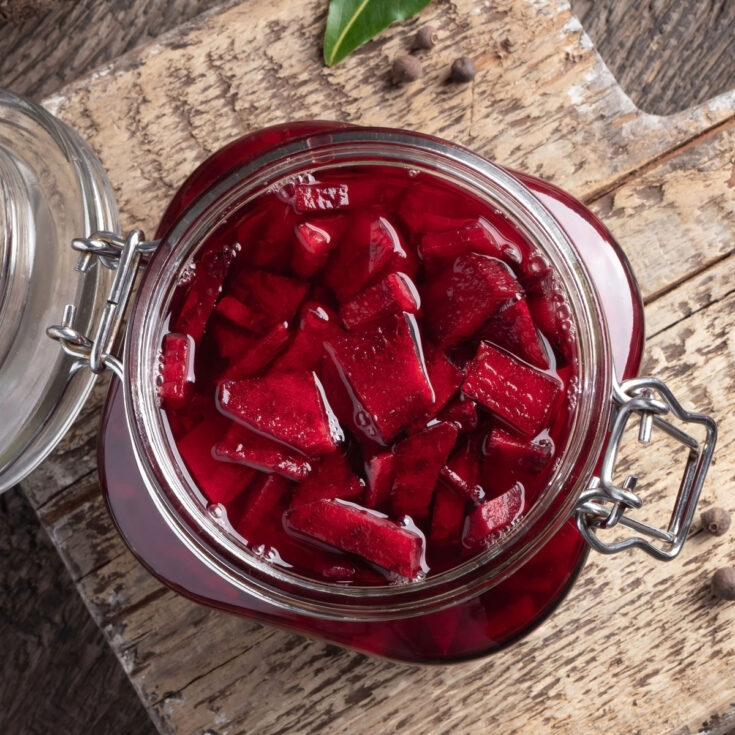Zakwas Buraczany (na Barszcz)
Beet Zakwas: Fermented Beet Juice
How to pronounce it?
zakvass boorah-cha-knee
‘Play’ to hear:

Fermented beet juice (also known as ‘beet kvass’) is the star ingredient of a Polish Red ‘Barszcz’ soup – a traditional Christmas classic.
Its flavour is unlike any other – slightly sweet, a bit vinous, with a pleasant tart aftertaste. The colour resembles the deep burgundy hues found in the finest wines.
For the full list of ingredients & detailed instructions, please see the recipe card at the end of this post. But before you scroll, there’s important stuff to know below.
Beet kvass can be easily made at home, in literally 5 minutes.
Beetroots are sliced and placed in a sterilized jar, and then covered with spring water. They’re fermenting for 5 to 7 days (or more) together with some garlic and spices. And that’s it. Drink it on its own, as a super-healthy probiotic shot; or add it to the soup.
Do you need any special ingredients or equipment to make this Beet Kvass?
Luckily, the ingredients shouldn’t be too difficult to source.
Firstly, we’ll need high-quality beetroots (traditionally red, but other colours work too).
Go for the ‘organic’ option (or from a trusted source) if you can. That way, there’s no need to peel them – just give them a quick scrub.
Personally, I like the elongated beets the most. In Poland, they’re the sweetest.
You’ll also need a large jar, or a few smaller ones.
What dishes can you make with these Fermented Beets?
The sour liquid is perfect for an array of Polish soups, such as Barszcz Czerwony (meat-free for Christmas Eve or cooked with meat stock throughout the year), Barszcz Zabielany (with Cream) and many more. I’ll cook some of them very soon.
You can also drink it straight-up, as a health “shot”. You can use it in smoothies and cocktails.
The remaining Sour Beets are great for salads and soups (leave them in chunks or grate them). You could also use them up for ‘Ćwikła’ (Polish beet-and-horseradish relish).
Can you make this Beet Kvass / Zakwas another way?
No, not really. The addition of salt (common salt, non-iodized) is optional here.
When making Red Borscht soup, some home cooks try to take a shortcut by swapping Beet Zakwas for vinegar – but believe me, it’s not worth it. Nothing compares to properly fermented beetroots.
How do you know when these Beets have fermented?
The exact fermentation time depends on the temperature, quality of ingredients and taste preference.
It’s best to test it organoleptically – it should be slightly sweet, yet tangy. If you can see (or smell) mould in the jar – throw it away, it’s beyond saving.
In general, beets are ready after about 5 to 7 days – although I allow my beets to ferment for much longer (even 2 weeks) because I like them very sour. The warmer the storage spot, the faster the fermentation process occurs.
What diets is this Fermented Beet Juice suitable for?
It’s suitable for all diets: vegetarian, vegan, gluten-free, dairy-free, keto/low-carb – you name it.
How long can you keep this Beet Kvass / Zakwas in the fridge?
Once fermented and refrigerated, Beet Kvass can easily survive many weeks over there. It will continue to ferment in the fridge but at a very slow rate. Just make sure you label it with a date, so you know when it was made.
Some strain the juice, others (like me) leave the beets in – I guess that’s up to you.
Can I freeze this Beet Kvass / Zakwas?
No, you shouldn’t.
There’s no reason for freezing, it lasts in the fridge for a really long time. If you’re not feeling confident – just make a smaller batch for the first few times.
FAQ & Troubleshooting
Can I buy a ready-made Beet Kvass?
Yes, but it won’t taste the same as the homemade version.
Moreover, to prolong the shelf-life, most of store-bought products like these are pasteurised. That means these juices are lacking in nutrition and probiotic qualities.
Glossary / Dictionary
- Zakwas Buraczany: a Polish term for a natural beverage made from fermenting beets.
- Beet kvass: a spin on the Russian/Ukrainian name for a natural beverage made from fermenting beets, popularized by Sally Fallon’s “Nourishing Traditions” (source). This name for it is recognized internationally.
- Lacto-fermentation: A natural process by which bacteria break down the sugars in food, forming lactic acid. This preserves foods and makes them tastier and healthier. (source)
- Barszcz Czerwony: (pronon. “Barscht Chervone”, known as Red Borscht) a type of a Polish beet soup. There are many varieties, most of them soured with fermented beet juice.

Beet Kvass (Zakwas) - Fermented Beet Juice (for Red Borscht)

This portion of Fermented Beet Zakwas / Kvass is enough to make Red Borscht soup for a family of four. I encourage you to double, triple or quadruple this recipe and drink this sour beverage as often as possible.
Ingredients
- 1-1.1 lb (500 g) beetroots, red
- 3 garlic cloves
- 2-3 bay leaves
- 3 black peppercorns
- 3 all-spice berries
- 2 cups (500 ml) water, spring water or boiled, then cooled
- 1 tsp common salt (non-iodized!), optional
Instructions
- Sterilise both the jar and the lid. Use a dishwasher (on the highest setting), or alternatively - wash them in warm, soapy water, then rinse thoroughly with boiling water.
- Give the beets a scrub. If you’re using conventionally grown beetroots, it’s best to peel them.
- Slice the beets into chunks or rounds - the exact size and shape doesn’t matter. Place the pieces tightly in a jar, squeezing garlic cloves and all the spices between the beets.
- Finally, pour the water in, enough to cover the beets fully. If you’re using salt, add a teaspoon of it, close the jar and shake it a few times.
- Take a one more look at the jar. Are the beets fully submerged? If they stick out or float, they’ll get mouldy. If you have trouble with keeping them down, it might be worth investing in fermentation weights.
- Screw the lid on loosely and leave the jar in a cupboard or on your worktop, at room temperature. It’s worth opening the jar every day to inspect and to release the gasses - we don’t want for the jar to explode.
- After 4 days grab a clean spoon and have a little taste. Depending on how sour it is (and how sour you would like it to be), leave it for another 1 to 3 days (or more). I usually wait 2 weeks or even longer, but that’s me - a ferment-loving loony ????.
- Beet kvass / zakwas is good when it has a deep, slightly sour aroma and a dark color. That’s when it’s ready to be used in the Christmas borscht.
Notes
- You'll need a 1.2 qt / 1.2 litre glass jar (or larger) for this recipe.
Nutrition Information:
Yield:
4Serving Size:
1Amount Per Serving: Calories: 57Total Fat: 1gSaturated Fat: 0gTrans Fat: 0gUnsaturated Fat: 0gCholesterol: 0mgSodium: 586mgCarbohydrates: 14gFiber: 5gSugar: 7gProtein: 1g
Polonist is reader-supported. When you buy through links on our site, we may earn a small affiliate commission. Learn more
Recipe Information
Filed under:
Alternative traditional/regional names:
Zakwas z Buraka, Zakwas z Buraków, Zakwas na Barszcz Czerwony
Also known / Misspelt internationally as:
Beet Kvass, Lacto-Fermented Beetroot Juice, Fermented Beet Drink
Tested by:
First published on:
Recipe by / Adapted from:
Story by:
Bibliography / References: